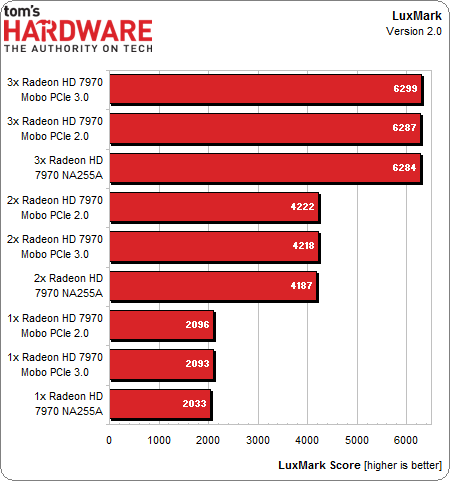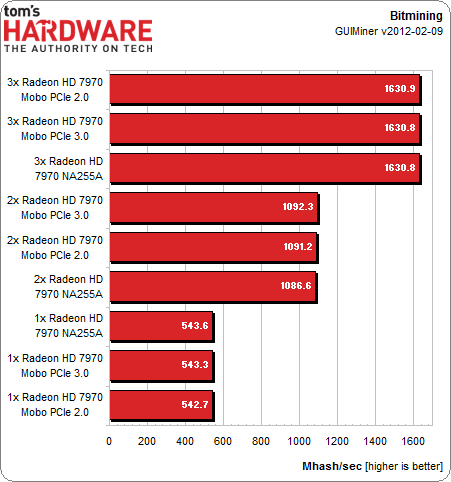External Graphics Over PCIe 3.0? Netstor's NA255A, Reviewed
Netstor sent over its TurboBox NA255A, an external enclosure capable of accommodating four dual-slot graphics cards across one 16-lane PCI Express 3.0 connection. Is this thing fast enough for general-purpose GPU compute workloads? How about gaming?
Results: General-Purpose GPU
Netstor's TurboBox NA255A is intended for multi-GPU workstations able to leverage the compute power of graphics hardware. So, we start our evaluation using LuxMark.
As you can see, there is no difference in performance between a motherboard operating a PCI Express 2.0 signaling, a motherboard at PCI Express 3.0, and the TurboBox. This workload fully utilizes each graphics card's compute resources, but it doesn't tax PCI Express bandwidth. Consequently, scaling is pretty much amazing.
Again, we see nearly identical results between the motherboard-based cards and Netstor's TurboBox. This means that we don't have any trouble going outside of the box or stepping down to PCI Express 2.0, at least in compute-bound workloads.
On a related note, we ran the same bitcoin mining test on a Socket FM1 motherboard using a PCI Express slot limited to four lanes of connectivity. The result was identical to our 16-lane tests, around 550 Mhash/second. In other words, we're not worried about one third-gen PCIe x16 slot serving up enough throughput for a fourth card in Netstor's NA255A TurboBox. We hypothesize that there's still headroom available.
Get Tom's Hardware's best news and in-depth reviews, straight to your inbox.
Current page: Results: General-Purpose GPU
Prev Page Test System And Benchmarks Next Page Results: Medal Of Honor WarfighterDon Woligroski was a former senior hardware editor for Tom's Hardware. He has covered a wide range of PC hardware topics, including CPUs, GPUs, system building, and emerging technologies.
-
dagamer34 Now if only we could get external GPUs via Thunderbolt (or it's future iterations) so that laptops wouldn't be forever gimped, we'd be in business!Reply -
Whooo whoo, if i had the money to burn, i would get this NA255A, remove the PSU bundle, replace it with a Seasonic 1000 Platinum, slap four GTX Titans, add a custom water-cooling loop, connect it to my main PC and have (if it works) three more NA255A's for each of the PCIe for the main PC with a grand total of 16 GTX Titans for massive GPU computation. All for a grand total of $13,800. Massive electric bill, here i come!Reply
-
mayankleoboy1 PCIE signals scale poorly to long wires. So it is a technical achievement to have these signals travel over a meter of wire.Reply -
A Bad Day dagamer34Now if only we could get external GPUs via Thunderbolt (or it's future iterations) so that laptops wouldn't be forever gimped, we'd be in business!Reply
There are some external GPU cases.
The only issue is that the cheapest is somewhere slightly less than $400.
Please explain to me how an aluminum box, a micro-PSU, and a Thunderbolt-to-PCIE adapter adds up to even $200... -
A Bad Day EDIT: And when I meant the cheapest, I meant the ones that are only sufficient for a 7750. Want to pair a 7970 with a ultrabook?Reply
$400-$500 for a slightly longer box with a slightly more capable PSU. -
Vatharian Good X79 workstation mobo with 7 PCI-e slots, and 4 K20x-s on each of them. That's a TON of computing power, and if you don't want to deal with high-speed networking multiple boxes, that's nice. Of course only if this thing can actuallty work in pairs or more and in some way circumvent the 15 gpu limit in bios memory mapping. Can this thing be turned on with working machine?Reply -
adgjlsfhk ReplyBut what about someone working on a Mac Pro? Apple's more limited ecosystem means there is no such thing as a three- or four-way graphics array. This could be one of the only options for enabling multiple GPUs. If massive compute potential is important, you might need to swallow hard and consider Netstor's solution the cost of doing business in Apple's world.
Or you could use the $2000 to ditch your mac pro that is years out of date and use the money to buy a pc that is better in pretty much every way.

